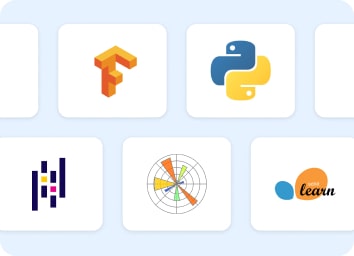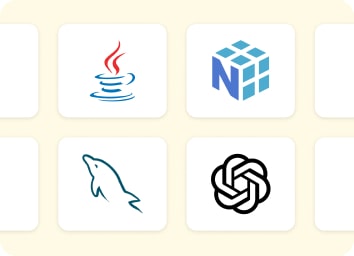Free Exploratory data analysis course
Basics of Exploratory Data Analysis
Learn how to uncover hidden insights and patterns in data through hands-on exercises and real-world examples. Enroll now and start your journey towards becoming a data analysis pro!
Instructor:
Mr. Bharani Akella
Ratings
Level
Learning hours

Learners
Skills you will learn
About this course
The Basics of Exploratory Data Analysis course shall imbibe in you the knowledge on working with Data Manipulation techniques with DPLYR and its functions to reduce the arduous task. The course shall then continue with Data Visualization techniques using the GGPLOT2 grammar package and different plots and layers. You will learn the statistics involved with the subject and the science supporting Data Science strategies. In the later part of this course, a case study on the Pokemon Dataset would be fun for you to apply these concepts and understand the subject as a whole. You can refer to the attached study materials at any point after enrolling in the course and take up the quiz at the end to test your knowledge and understand your gains.
Upon completing this free, self-paced, beginner's guide to Basics of Exploratory Data Analysis, you can embark on your Data Science and Business Analytics career with a professional Post Graduate certificate and learn several concepts with millions of aspirants across the globe!
Course Outline
In this section, you will learn and understand data manipulation techniques with DPLYR packages to work with a massive data set. You will know how to install the DPLYR package and how to extract specific data from the pool data pool demonstrated code snippets.
This section explains the grammar of data visualization and then continues by speaking about three different layers in it. You shall then perform data visualization operations with GGPLOT2 grammar of graphics after knowing how to install it.
In this section, you shall apply data manipulation and visualization techniques that you learned in the earlier part of the course on the Pokemon dataset to understand better and good hold on the concepts.
What our learners enjoyed the most
Skill & tools
64% of learners found all the desired skills & tools
Our course instructor

Mr. Bharani Akella
Data Scientist
Data Science Expert
Frequently Asked Questions
Will I receive a certificate upon completing this free course?
Is this course free?
What are the prerequisites required to learn this Basics of Exploratory Data Analysis course?
It is beneficial for you to learn statistics and either R or Python programming before you enroll in the course.
How long does it take to complete this free basic of Exploratory Data Analysis course?
The Basics of Exploratory Data Analysis is a 1.5 - hours long course and is self-paced. Once you enroll, you can take your own time to complete the course.
Will I have lifetime access to the free course?
Yes, once you enroll in the course, you will have lifetime access to any of Great Learning Academy’s free courses. You can log in and learn whenever you want to.
Other Data Science tutorials for you
Basics of Exploratory Data Analysis
An exploratory data analysis is the critical process of using summary statistics and graphs to look for patterns, spot anomalies, test hypothesis, and check assumptions and understand the given dataset, and help to clean it up. You can see a clear picture of the features and their relationships. It sets guidelines for essential variables and leaves behind/removes non-essential variables. An EDA process would maximize insights from a dataset. It is crucial to eliminate irregularities and clean the data after it has been entered into our system. The exploratory data analysis (EDA) allows us to see beyond the data. As we explore the data, we draw more insights. Data analysts spend almost 80% of their time understanding data and resolving business problems through EDA.
Exploratory data analysis
EDA or exploratory data analysis refers to understanding data sets by summarizing their main features and visually presenting them. Often, it takes much time to explore data, and we can ask to define our data set's problem statement or definition through EDA, which is vital. In Python, data visualization is used to draw meaningful patterns and insights. Preparation of data sets for analysis includes removing irregularities from data sets. As a result of EDA, companies make business decisions that can have repercussions later on.
- * EDA can have a negative impact on further steps in the machine learning model building process if not done correctly.
- * The efficacy of everything we do next may be improved if this is done well.
Today, exploratory data analysis is one of the best practices in data science. Starting a career in data science, most people aren't aware of the difference between data analysis and exploratory data analysis. Although there is no wider difference between them, they serve varying purposes.
Exploratory Data Analysis (EDA): It is a complementary method to inferential statistics, which tends to be more rigid. Advanced EDA involves describing and analyzing a data set from multiple angles before summarizing it.
Data analysis is the process of figuring out trends from the data set based on statistics and probability. It shows historical data using analytics tools. Drilling down the information helps transform metrics, facts, and figures into initiatives for improvement. We will understand different variations a data set and perform exploratory data analysis using Python. You can learn Python online with our Python course.
EDA process includes:
- * Missing value handling
- * Duplicates should be removed
- * The outlier treatment
- * The normalizing and scaling of numerical variables
- * The encoding of categorical variables (dummy variables)
- * A bivariate analysis of the data
As part of this step, we will perform the following operations to determine what the data set consists of:
- * The dataset's head
- * Dataset shape
- * The dataset information
- * a summary
You can use the head function to find the top records in a data set.
Python shows you only the top five records by default.
The shape attribute tells us how many observations and variables there are in the data set.
Exploratory data analysis using Python
Python's exploratory data analysis (EDA) is the first step in the data analysis process developed by "John Tukey" in the 1970s. Exploratory data analysis, in statistics, denotes a process of analyzing data sets to summarize their main characteristics, usually using visual illustrations. The exploratory data analysis (EDA) results are analyzed visually by summarizing their key features. This process is vital, especially in the cases where we apply machine learning to the data. EDA has many plotting options, including histograms, box plots, scatter plots, and more. Exploring data often takes a lot of time. EDA allows us to define the problem statement or definition built on our data. This is vital.
It is surely one of the very important steps in EDA to load the data into the Pandas data frame, as the values from the data set are comma-separated. We have to read the CSV into a data frame, and the panda's data frame handles the rest for us.
Execute a straightforward step to get or load the dataset into the notebook. Google Colab has a ">" (greater than symbol) at the left-hand side of the notebook. You will be navigated to a tab having three options. When you click it, you should select Files. Using the Upload option, you can easily upload your file. There is no need to mount to Google Drive or use any specific libraries. Just upload the data set, and you're done. When the runtime is recycled, uploaded files will be deleted. This is how I imported the data set into the notebook.
Example: Sometimes, the MSRP or the price of the car may be stored as a string or object; in that case, we have to convert that string into integer data, and then we can plot the data.
EDA in data science
Exploratory data analysis involves analyzing data sets to summarize their key characteristics, often using statistical graphics and other data visualization techniques.
- * Understanding data
- * Differentiating data patterns
- * A better-quality understanding of the problem statement
- * Clustering and dimension reduction techniques create graphical displays of high-dimensional data containing several variables.
- * The statistics summary is visualized univariately for all fields of the raw dataset.
- * Overview of bivariate visualizations and summary statistics allow you to assess the connection between every dataset variable and the target variable.
- * Bivariate visualizations and summary statistics help you assess the relationship between each variable.
- * A K-means clustering is an unsupervised learning method in which data points are allocated to K groups, i.e., the number of clusters, depending upon the distance from the centroid.
- * The data points that are close to a particular centroid are grouped together.
- * The K-means clustering process is generally used in market segmentation, pattern recognition, and image compression.
- * In a predictive model, such as linear regression, statistics and data are used to predict outcomes.
Exploratory Analysis
What is exploratory data analysis?
It is one of those questions that everyone is interested in knowing the answer to. The answer depends on the data set you're working with. Even though there is no sole method or standard way to perform EDA, in this tutorial, you will be familiarized with some standard methods and plots that will be used throughout the process.
Exploratory data analysis in R
- * The first step is to approach the data.
- * The second step is to analyze categorical variables.
- * The third step involves analyzing numerical variables.
- * Analyzing numerical and categorical data simultaneously.
Exploratory Data Analysis Example
So, when would we use exploratory data analysis in the marketing field? Let's consider that you work for a retailer that sells 1000 different kinds of shoes—Dress shoes, hiking boots, sandals, etc. Through EDA, you open yourself to the fact that many people might buy any number of different types of shoes. Using exploratory data analysis, you discover that most customers buy 1-3 different types of shoes. Sneakers, dress shoes, and sandals seem to be the most popular types. At least you were open to diverse potentials. However, the data helps you see something else after a closer look. A small but a considerable group of people buy 50 or more types of shoes each year. This would not be easily visible without EDA, and without being open to this possibility, you might have dismissed the idea outrightly.
Exploratory Data Analysis Courses
A good program that is delivered well by Great Learning. All the classes are helpful and engaging. If you feel that the subject is dry, the faculty will handle it in an exciting way. The panel is informative and connected to the audience and will address the crowd in the best approach possible. You can choose between online or offline classroom sessions with offered mentorship from industry experts. Resume and interview preparation with industry experts & exclusive job board from UT Austin, Stanford, ISI, and Great Lakes faculty.



















.png)





 (1).png)



.png)





.png)
.png)
.png)
 (1).jpg)
.png)
.jpg)











.jpg)
.jpg)
.jpg)








